My husband and I just returned from our 22-day honeymoon in Japan in May 2023. I wanted to share our adventure with a little “accessibility assessment” of our Japan trip.
“Just do it, take the leap and you’ll be rewarded. I’d choose Japan again in a heartbeat.” – Cati Van Reeth
We are from Belgium (Europe), and I am in a manual wheelchair for longer distances, which means I can walk and do a few steps or stairs. I hope this information will be useful for others planning an accessible trip to Japan.
As we were researching our trip, we found little info that could properly prepare us for accessibility in Japan. We were very confident we had picked the right destination.
We visited Tokyo (days 1-6 and 18-22), Kyoto (days 6-12), Nara (day 12), Osaka (days 12-14), Kobe (day 15) and Lake Kawaguchiko (days 16-18). May I remind you that our itinerary is completely personal and tailored to our wishes and expectations. So, without further ado, here are our thoughts about what we experienced in beautiful Japan.
Flying with JAL to Japan
We flew with Japan Airlines and had one stopover in Helsinki, and the service was beyond amazing. We decided to get “premium economy” seats, as it was our honeymoon and wanted to treat ourselves. Totally worth it, in my personal opinion. Their assistance during the stopover was excellent, as we were fully informed about the whereabouts of our wheelchair.
Our Experience Travelling Around Japan with a Wheelchair
Our hotels were strategically located near the stations we knew we were going to pass frequently. All of them were fully wheelchair accessible, but we researched that beforehand.
Also, the train stations, subway and others, are in fact, all wheelchair accessible with elevators. However, sometimes the elevators are not so easy to find. This means sometimes having to enter a nearby store, use the elevator to the first basement level, and then find another elevator that takes you to the tracks.
Maps is your friend in Japan, but it doesn’t know about accessibility in Public Transport mode. If you’re using the standard app on iPhone, make sure you add extra time to find your entrance. Google Maps is worth downloading separately. Just dive into the settings and you’ll be able to use Public Transport-mode and tell it to avoid stairs.
Fortunately, all the trains in Japan are super punctual and also frequent. Missing your train doesn’t really exist. There will likely be another one shortly. Also, don’t hesitate to ask for help, especially if you’re travelling alone (yes, we think travelling alone in a wheelchair is possible in Japan).
The person who is stationed at the wider entrance gate for wheelchair users (where you scan your IC card) has proven to be the most reliable source of information. They will, nine times out of ten, ask you what your final destination is. They will then arrange for someone to either assist you in the station itself or at least arrange a ramp for you to enter the train in the designated area. In every few compartments, there is an area without seats for wheelchair users, same with all buses where they will fold up two seats to make room.
One time, on a Sunday, we were travelling from Kawaguchiko Station to Ikebukuro Station in Tokyo. We had to switch trains two times along the way. We couldn’t believe it when we realised that the Kawaguchiko station workers had arranged for other station workers to be waiting for us with a ramp at the exact door we had entered the train. All the way to Ikebukuro, we didn’t have to worry about a single thing, and we could enjoy the views of the countryside.

Travelling to Japan in a Wheelchair Was a Surprising Experience!
Travelling with a wheelchair has always been an incredible source of stress for me personally because even in my own country, you just can’t relax and rely on the services. For an able person, it’s probably very hard to imagine the inability to simply go wherever you need to. The freedom to decide on the spot. The small gaps and the “one” step that keep you from being on time to freely explore.
That is why Japan has been like a breath of fresh air to us. To see what is possible without having to change the whole infrastructure. I always say that I’m only as limited as my surroundings make me, and in Japan, I felt like there were no limits to what we could do.
I did have my husband to push my chair, but many of the station workers (and even fellow passengers!) offered to help. Even the buses have the most mindful drivers who will definitely take good care of you. In short, I do recommend Japan as a destination if you’re a person with any type of physical disability.
The Japanese treat you with the utmost respect and dignity, and it’s very refreshing. One time, one of the bolts from my wheelchair went missing, and the front wheel was getting loose. Over time it would have come off completely without the bolt holding it in place.
So we stepped into the first hardware store we could find in Kyoto, and a very nice gentleman set us up with a shiny new bolt. We offered to pay for it and his services, but he declined payment. Our grateful hearts were filled with pure joy about this gesture by, as we have dubbed him “Makita man”.
We’re happy to say most shrines are wheelchair accessible, which was something I was very worried about when we were planning. Ramps or elevators are usually around somewhere. This being said, as a tourist, be aware that when you wish to enter a temple (the part where everyone removes their shoes), you will probably have to settle for looking from a distance. I’m sure that a disabled Japanese person will be able to enter somehow.
In the city, there will be lowered sidewalks at crossroads, as you would find in most cities anywhere. In the countryside, however, sidewalks will most likely be absent. At least, that eliminates the problem of getting caught on the edge of the sidewalk.
Many restaurants require you to use stairs to enter because they are located on the second or third floor or are so cramped that you can’t park your wheels anywhere. But you can rest assured there are many alternatives to whatever you’re craving. There’s a chance you won’t be able to dine at “that one place you saw on Instagram”, but take it from our experience. The place across the street will probably have a bunch of other things you’ll definitely like.
But that’s the thing with popular places. People will line up for sometimes hours while there are perfectly great alternatives around. We, for one, never lined up for anything except for Universal Studios Japan (USJ). We rarely made reservations in advance either, simply because we wanted the freedom to explore day to day, depending on the weather and such.
“On a roll” exploring Tokyo
Here are some of the experiences we had and places we visited worth telling you a little more about. Obviously, we did a great many other things on our three week Japan itinerary, but I decided to select a few topics to keep things relevant.
The first week we spent in Tokyo and it was nothing short of amazing.
Harry Harajuku Otter Cafe
The Harry Harajuku Otter Café on Tokyo’s Cat Street was not wheelchair accessible at all as it’s on the third floor. The only way to enter was via a long metal staircase. With great effort, I made it up there. Didn’t need a reservation to get in. It was fun to interact with the animals. We noticed the staff take good care of the animals and hygienic precautions were taken.
Mameshiba Café at Takeshita Street in Harajuku
Mameshiba café at Takeshita Street had an elevator. However, the space was very cramped, and you can’t take the chair into the room where the dogs are.
You have to go in and get a reservation for that day. They’ll give you a time to return to avoid overcrowding the already crowded room. The dogs seemed uninterested in the many guests they had to entertain, which is very understandable. We did have some concerns about the dogs’ wellbeing.
Zojoji Temple near Tokyo Tower
In Zojoji Temple, the temple for miscarried and stillborn children, many of the Children’s effigies are further along a corridor that you can only reach through stairs. So not very accessible, depending on your mobility.
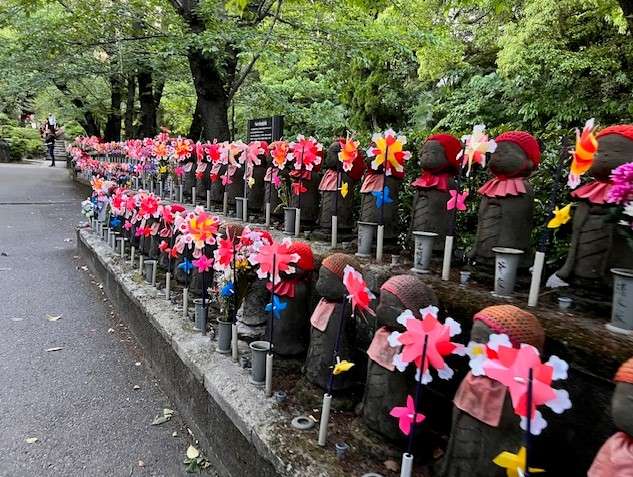
Disneyland Tokyo and Disneysea Resorts
Upon showing an official proof of disability, you can get a significant discount at the parks but you’ll have to queue with everyone else.
We went to the Disney Sea counter but ended up exploring more of Tokyo instead, as we had already spent a day queuing at USJ the week before.
Shunkaen Bonsai Museum in Edogawa
The Shunkaen Bonsai Museum in Edogawa was technically accessible if it weren’t for those darn charming uneven pavement stones that make it a beautiful Japanese garden. I was lucky to be able to get up and walk around the place, as it was very calm.
Kabuki Performance in Tokyo
We also wanted to go to a Kabuki performance at Kabuki Theatre, as I had researched that it would be wheelchair accessible. Unfortunately, they were not selling any Single act tickets for the time being. I think they will go back on sale somewhere in June ‘23. Just FYI.
Exploring Kyoto with a Wheelchair
Below are the places we explored in Kyoto. Compared to Tokyo, Kyoto will feel slightly less accessible, simply because of its authentic nature.
Kiyomizu-dera Temple
Kiyomizu-dera Temple is a must see when you’re in Kyoto. It will be crowded at whatever time you decide to go, and this will cause inconveniences and many oopsies when people start bumping into you. This is understandable because they are paying attention to the views and not the road. The way up for the general public has many stairs, but the VIP-entrance -as I’d like to call it- around back is stairs-free. Just follow the Wheelchair-signs.
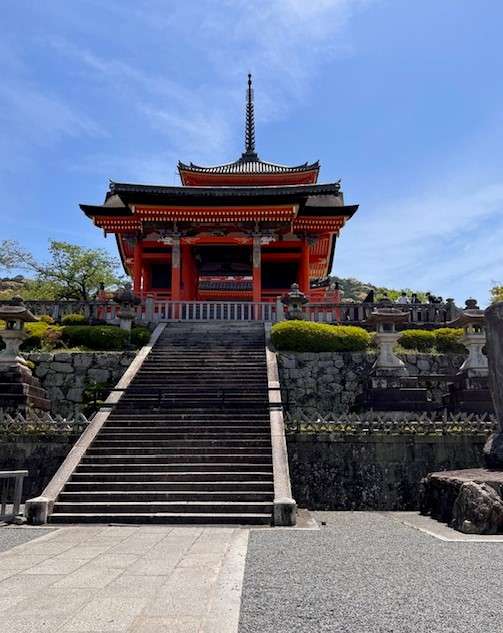
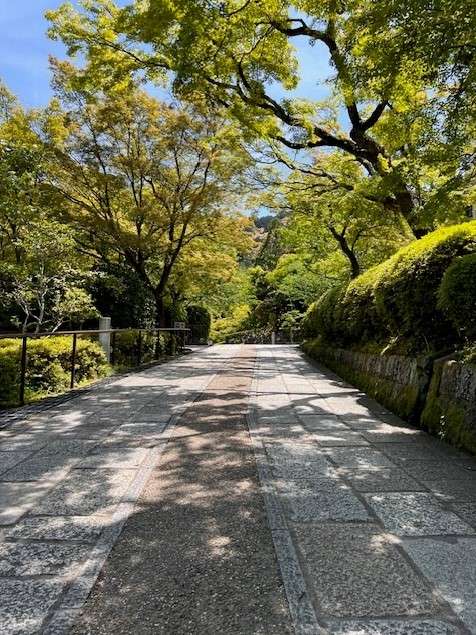
On the way up, your own views will mostly consist of butts and crotches, all the good stuff that comes with the chair. If you can drown that out, you will be able to enjoy the visit because once up there, it is truly an amazing view.
Please know that one part of the way up, there is a VERY steep piece of road that made my husband sweat, to say the least. If you manage to push through, it’ll be worth your effort, I promise.
Ninenzaka and Sannenzaka Streets
Ninenzaka and Sannenzaka Streets in Gion are both steep roads, and Sannenzaka will not be accessible due to stairs, simple as that, but the parts that are accessible are plentiful. You’ll for sure be able to take that iconic picture with the Hokanji pagoda.
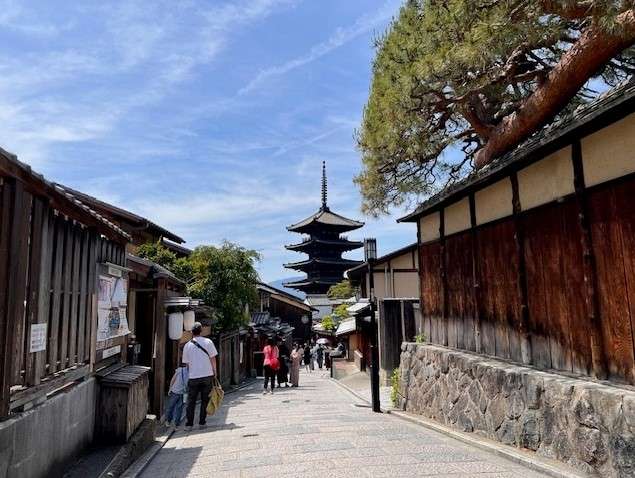
Most shops are inaccessible and small. It really depends on how agile you are. For example, the Maccha house had a narrow entrance with a bunch of uneven stones as pavement to resemble a Japanese garden. Once you overcome that, there’s no problem enjoying a nice matcha tiramisu.
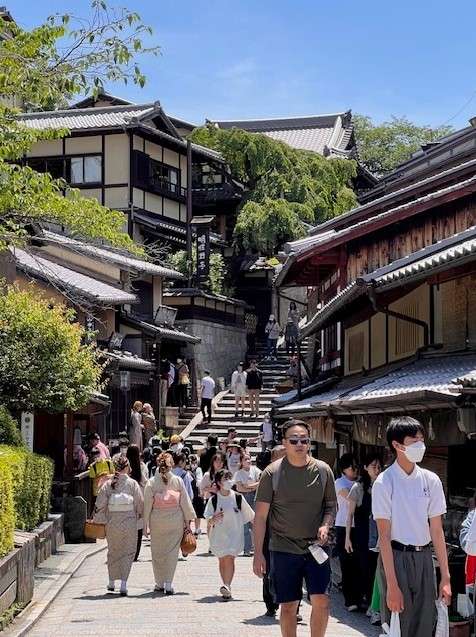
Fushimi Inari Taisha Shrine
Fushimi Inari Taisha was one of the highlights of our trip. Believe it or not, but this is wheelchair accessible if you know where to go. You will need to bypass some sections, which you can later still do downwards if you have a skilled “driver”.
There’s an elevator to get to the first part, but you’ll have to do some stairs if you want the experience everyone does. However, there’s a path in the back, basically the halfway exit, that is without any stairs.
I recommend going up that way and making your way down through the Tori-gates. Sadly, for electric wheelchairs, it’s a little more complicated… It saddens me that certain people have to miss out on such a beautiful place. I remain hopeful that in the future, the Japanese will invent something that will definitely make it better!
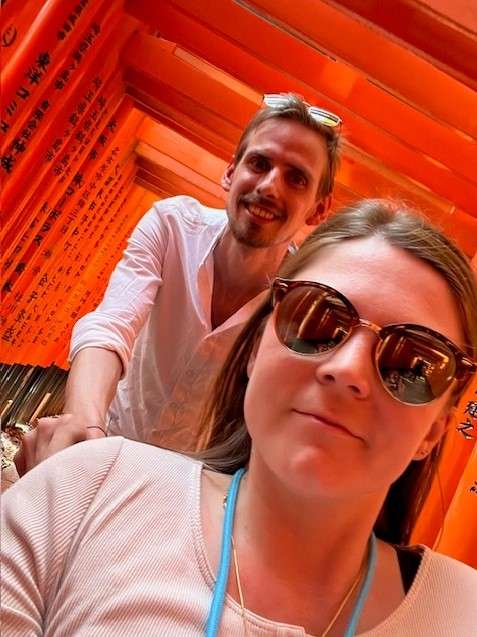
Arashiyama Bamboo Grove
Arashiyama Bamboo Grove was actually quite underwhelming, mostly because of the heedless crowds and the fact it’s really not that big of an area to explore.
We wanted to take the Sagano romantic train up the valley. Unfortunately, the station staff explained to us there were 60 steps to get down to the platform and that it was in no way wheelchair accessible. That was definitely a downer.
Also, the Hozugawa riverboats didn’t run at all during the week we were there, so then there’s that.
We explored the park area instead and visited some shops. We had also booked a private onsen and 9-course kaiseki dinner at Hanaikada traditional ryokan.
I had to leave the wheelchair at the entrance in order to take off our shoes and walk inside, so this is definitely not accessible. Also, to reach the onsen, you had to climb a whole bunch of stairs. It was charming though, with a nice view, so we enjoyed it nonetheless.
The nearby Arashiyama Monkey Park is, sadly, also inaccessible to wheelchair users as it is on top of a hill with steep paths and many steps.
Kinkaku-ji (Golden Pavilion) and Ginkaku-ji (Silver Pavilion)
Kinkaku-ji and Ginkaku-ji, the Golden and Silver Pavilions, I would like to say they are accessible, but they’re not, at least partly.
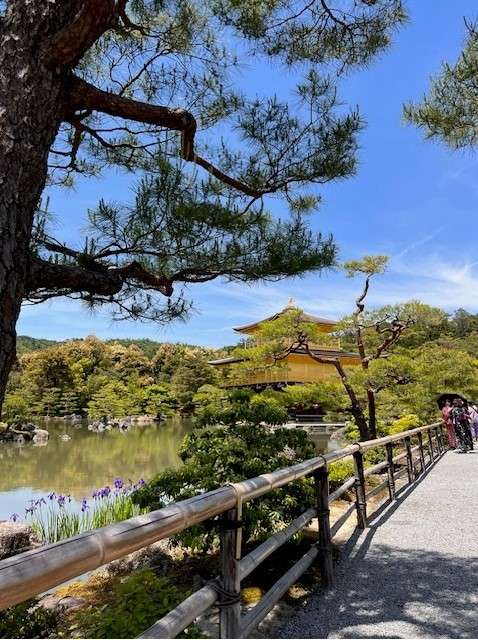
With the Golden Pavilion, there are many stairs if you wish to do the full circle in the beautiful garden. You can alternatively see the Golden Pavilion and then turn back the way you came, which means missing out on 70% of the park (for which you paid to see).
The Silver Pavilion also has a beautiful garden. However, there is a section of the garden that is only accessible via stairs. My husband quickly ran up there to take some photos of the amazing view.
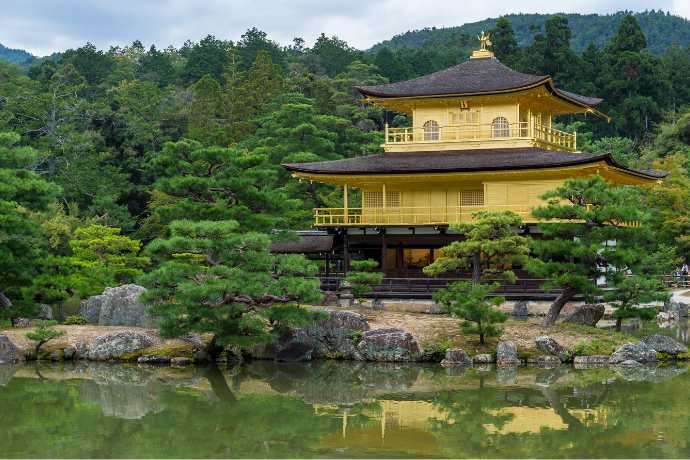
Kyoto Imperial Palace
Kyoto Imperial Palace is an interesting one. To get there, you’ll have to face an incredible sea of gravel, so you’ll have to see if it’s worth it or not. Once inside the Palace gates, you will be offered a wheelchair with electric assistance. After you transfer into the provided electric wheelchair you can then do the whole tour around the grounds without effort.
Philosopher’s Path
The Philosopher’s Path, don’t do it. I bet it’s nice when the blossoms are blooming, and perhaps one small section is worth a shot. However, given all of the oncoming visitors and the uneven “pavement”, it’s just not worth the hassle.
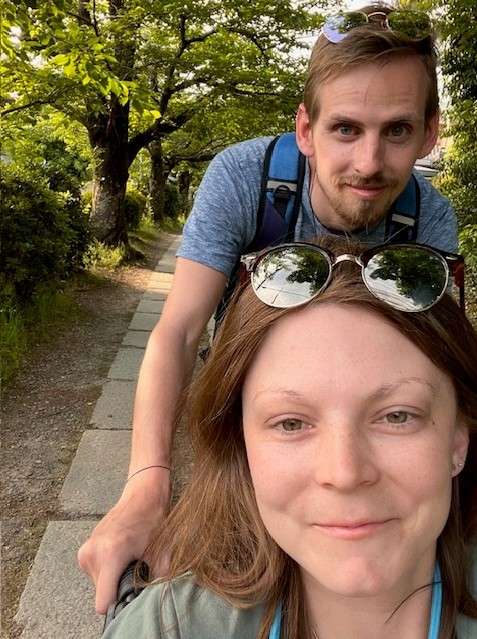
Exploring Osaka in a Wheelchair
Below are places we explored in Osaka.
Osaka Castle
Osaka Castle is another must-see. Other visitors are dropped off at the top and must use the stairs to go down, but if you’re in a wheelchair, they will let you use the elevator at will.
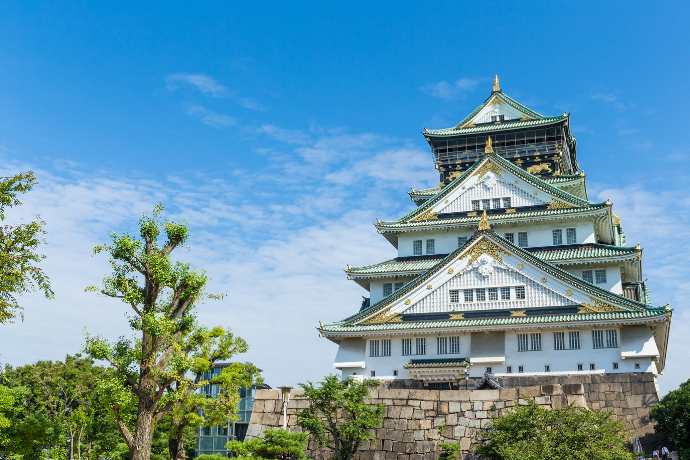
Umeda Sky Building
The Umeda Sky building was cool, but they didn’t let me do the escalator that crosses the building way up high, which looks like a whole experience in itself. That was disappointing.
TeamLab Botanical Garden
In TeamLab Botanical Garden, the staff were very helpful, but one of the exhibits was inaccessible for wheelchairs. I wanted to get out of the chair and do that one bit on foot, but I am very unstable on my feet. Other visitors were quite rough with the eggs, so I was nervous about getting bumped and falling over.
Universal Studios Japan
We only ended up going to USJ, simply because of the waiting times at Disneyland/Disney Sea. At USJ we picked the rides we wanted, and all of it was accessible. However, you should check the ride descriptions in the app or check with the staff, as not everyone has the same level of mobility.
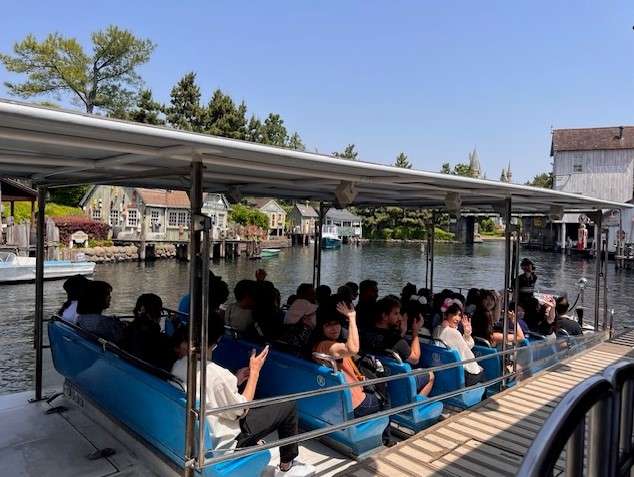
Nunobiki Herb Garden in Kobe
Nunobiki herb garden is a beautiful garden in Kobe that is very accessible, but you have to know where to go. Don’t enter it in your standard Maps app on iPhone, you will get lost if you select “on foot” and “avoid stairs”. Use the Google Maps app for more accurate results.
The entrance is next to the shopping centre, on Kitano Street, near “sandwich bakery Fork”. There you take the elevator or escalator, whichever you prefer, and you’ll find the ropeway.
At the gardens, you will also be offered an electrically assisted wheelchair, as the path down is extremely steep. Don’t forget to stop at the herbal foot bath, with a lovely view over Kobe!
Exploring the Kawaguchiko lake area with great Fuji views
Fuji-Go Q tour via Airbnb
We booked the Fuji-Go Q tour via Airbnb. This was an absolute winner for an experience to explore the Lake Kawaguchiko shores with restored electric mini cars.
The guide is from South Africa and English speaking. He is very well-travelled and has a Japanese wife, so now he lives in Kawaguchiko and knows all about the area and the culture. Another highlight of our vacation, slightly expensive but worth it. Check it out on Airbnb and let the reviews speak for themselves.
Kachi Kachi Ropeway new Kawaguchiko Station
The Kachi Kachi ropeway, in one word: tourist trap. You’re queuing to get up there. You’re queuing to take pictures of Fuji-san. You’re queuing even longer to get down. And the best part is, it’s not wheelchair accessible AT ALL. The staff will be confused if you say you can get up and walk a bit, and they’ll let you go up there, but trust me, it’s not worth your effort.
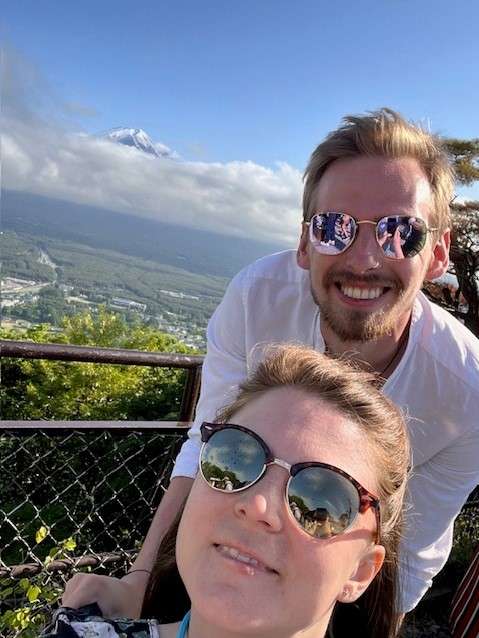
Conclusion and final advice
Finally, I would like to encourage all people with an officially diagnosed disability to inquire about a disability discount, like EVERYWHERE. It’s only advertised sometimes, but we learned halfway through our trip that most places do offer a discount when you show them official proof of your disability.
As a European, I have a blue European Disability Card. We were only denied the discount on one occasion, which was at the Diamond and Flower Ferris wheel in Kasai Seaside Park in Odaiba. They required the official Japanese Disability Card, which we obviously don’t have.
So please, however awkward it may feel, just ask. Chances are that some parts of the exhibit, or whatever you’re out there to experience, will be different for you from the chair. The best example would be the TeamLab Botanical Garden. There was one specific area that was not wheelchair accessible, and we needed to bypass it. Tuck away your reluctance and save some money, which you will most likely have to spend on transportation anyway.
This post has gotten way out of hand, but I wanted to contribute to this group in the best way possible. Hopefully, this will help even a few adventurous souls out there, able and disabled alike.
If you’re the former, this could be eye-opening, and I invite you to be mindful of the things you are maybe taking for granted. It could put things into perspective for all of us. If you’re the latter, I can only conclude this post with one thing: just do it, take the leap, and you’ll be rewarded. I’d choose Japan again in a heartbeat. We’re definitely going back at some point!
Thank you for reading, and ganbatte!
Cati Van Reeth

Join the Japan Travel Planning Facebook Group or Discord Server
You are also welcome to join our Japan Travel Planning Facebook Group and our Japan Travel Planning Discord Server – they are great resources to enable you to ask questions about your upcoming trip to Japan!
Disclaimer: This article contains affiliate links. If you book after clicking on one of these links then we may receive a small commission at no extra cost to you.

